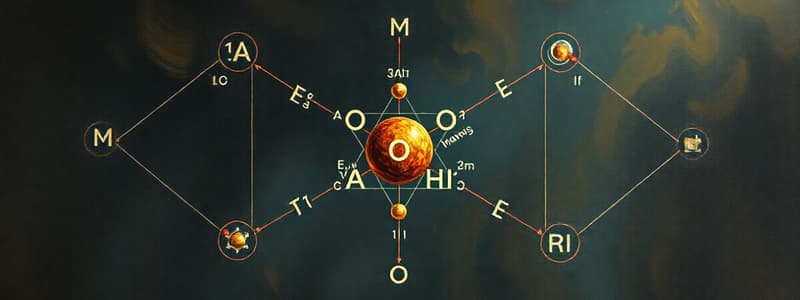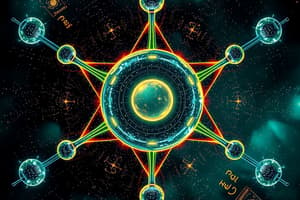Podcast
Questions and Answers
What is the maximum number of electrons that an orbital can contain?
What is the maximum number of electrons that an orbital can contain?
- 4
- 8
- 1
- 2 (correct)
Which of the following correctly represents the rule for writing atomic symbols?
Which of the following correctly represents the rule for writing atomic symbols?
- The atomic symbol must always consist of two letters.
- The first letter must be lowercase and the second uppercase.
- The symbol can consist only of lowercase letters.
- The first letter must be uppercase, while the second, if present, must be lowercase. (correct)
What is true about the relationship between protons and electrons in a neutral atom?
What is true about the relationship between protons and electrons in a neutral atom?
- Protons outnumber electrons.
- Protons and electrons are equal in number. (correct)
- Electrons outnumber protons.
- There is no fixed relationship.
Which atomic symbol is incorrectly formatted based on the rules provided?
Which atomic symbol is incorrectly formatted based on the rules provided?
What describes where protons and neutrons are located in an atom?
What describes where protons and neutrons are located in an atom?
Flashcards are hidden until you start studying
Study Notes
Atomic Structure
- Protons and neutrons reside within the nucleus of an atom.
- Electrons orbit the nucleus.
- Each electron orbital can hold a maximum of two electrons.
- Neutral atoms have an equal number of protons and electrons.
Atomic Symbols
- Atomic symbols use one or two letters to represent elements.
- The first letter of the symbol is always capitalized.
- The second letter, if present, is lowercase.
- Atomic symbols are derived from the element's name. Several symbols originate from Latin.
Studying That Suits You
Use AI to generate personalized quizzes and flashcards to suit your learning preferences.




